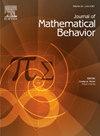Does understanding moderate aesthetic appraisals of proofs?
IF 1.7
Q3 EDUCATION & EDUCATIONAL RESEARCH
引用次数: 0
Abstract
The relationship between understanding and aesthetic appraisal in mathematics is an open question, with implications for both the philosophy of mathematics and mathematics education. In this study, we investigated how undergraduate students’ understanding of a mathematical proof relates to their perception of its aesthetic value. Participants were asked to evaluate the proof’s aesthetics and to complete three different assessments of their understanding. The results reveal that self-reported understanding was moderately associated with aesthetic appraisals, while two performance-based measures of understanding showed close-to-zero relationships. These findings challenge the view that aesthetic judgements in mathematics are merely disguised epistemic judgements, and suggest that future research should focus on exploring the non-epistemic factors that shape aesthetic judgements. We conclude by discussing the implications of these results for educational practices that seek to promote aesthetic experiences.
理解是否能缓和对证明的审美评价?
数学理解与审美评价之间的关系是一个悬而未决的问题,对数学哲学和数学教育都有影响。在本研究中,我们调查了大学生对数学证明的理解与他们对其审美价值的感知之间的关系。参与者被要求评估证据的美学,并完成对他们理解的三种不同评估。结果显示,自我报告的理解力与审美评价有一定的关系,而两种基于表现的理解力测量则显示出接近于零的关系。这些发现挑战了数学中的审美判断仅仅是伪装的认知判断的观点,并建议未来的研究应侧重于探索塑造审美判断的非认知因素。最后,我们讨论了这些结果对寻求促进审美体验的教育实践的影响。
本文章由计算机程序翻译,如有差异,请以英文原文为准。
求助全文
约1分钟内获得全文
求助全文
来源期刊

Journal of Mathematical Behavior
EDUCATION & EDUCATIONAL RESEARCH-
CiteScore
2.70
自引率
17.60%
发文量
69
期刊介绍:
The Journal of Mathematical Behavior solicits original research on the learning and teaching of mathematics. We are interested especially in basic research, research that aims to clarify, in detail and depth, how mathematical ideas develop in learners. Over three decades, our experience confirms a founding premise of this journal: that mathematical thinking, hence mathematics learning as a social enterprise, is special. It is special because mathematics is special, both logically and psychologically. Logically, through the way that mathematical ideas and methods have been built, refined and organized for centuries across a range of cultures; and psychologically, through the variety of ways people today, in many walks of life, make sense of mathematics, develop it, make it their own.
 求助内容:
求助内容: 应助结果提醒方式:
应助结果提醒方式:


